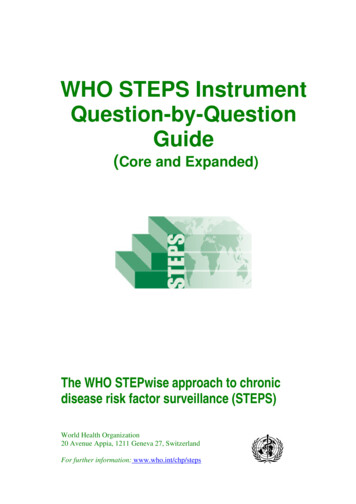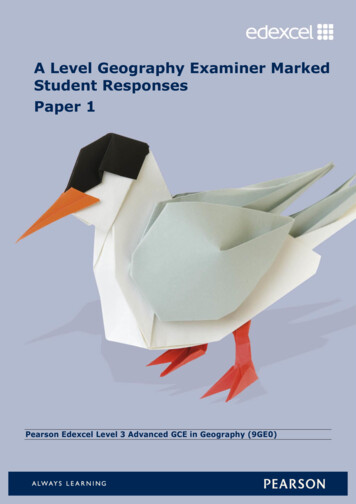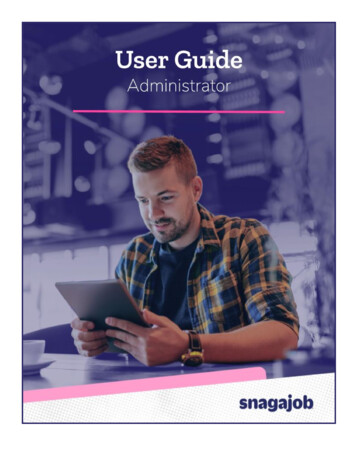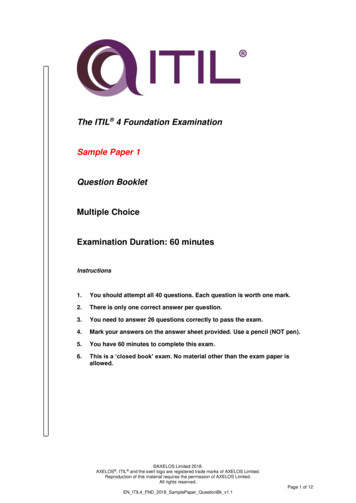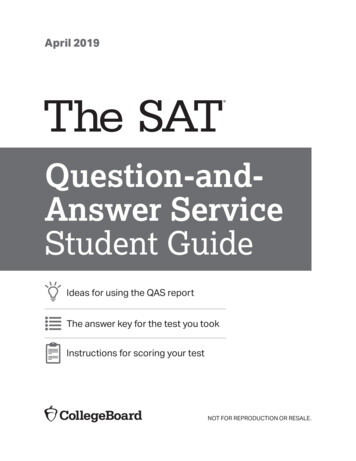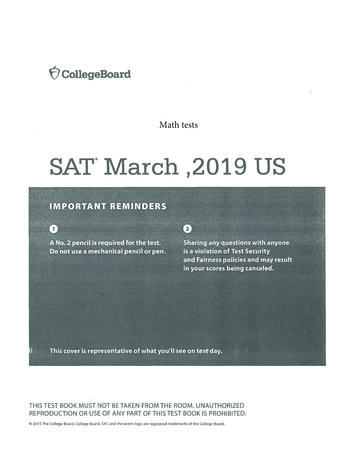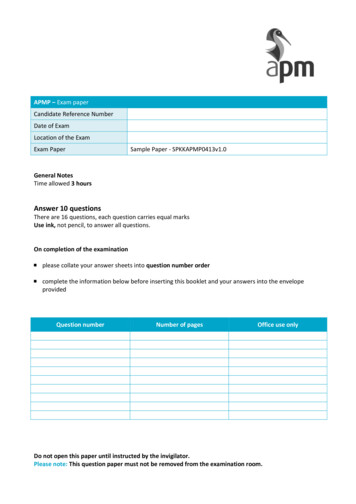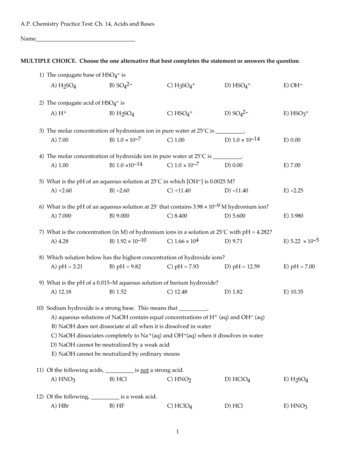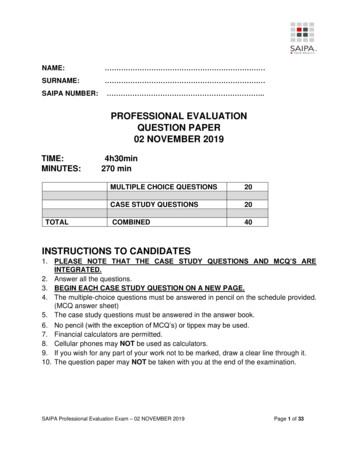
Transcription
NAME: SURNAME: SAIPA NUMBER: .PROFESSIONAL EVALUATIONQUESTION PAPER02 NOVEMBER 2019TIME:MINUTES:TOTAL4h30min270 minMULTIPLE CHOICE QUESTIONS20CASE STUDY QUESTIONS20COMBINED40INSTRUCTIONS TO CANDIDATES1. PLEASE NOTE THAT THE CASE STUDY QUESTIONS AND MCQ’S AREINTEGRATED.2. Answer all the questions.3. BEGIN EACH CASE STUDY QUESTION ON A NEW PAGE.4. The multiple-choice questions must be answered in pencil on the schedule provided.(MCQ answer sheet)5. The case study questions must be answered in the answer book.6. No pencil (with the exception of MCQ’s) or tippex may be used.7. Financial calculators are permitted.8. Cellular phones may NOT be used as calculators.9. If you wish for any part of your work not to be marked, draw a clear line through it.10. The question paper may NOT be taken with you at the end of the examination.SAIPA Professional Evaluation Exam – 02 NOVEMBER 2019Page 1 of 33
CASE STUDYBackgroundWith one of the top performance histories in the local industry, Tech-Fan Computers (Pty)Limited (hereafter referred to as Tech-Fan) is a technology development and computermanufacturing company with a focus of integrating into the 4IR environment. Tech-Fanwas founded by Mr. I. Fan (director and shareholder) and Judd Woznext (the COO) in 2005and since then it has revolutionized the South African technology industry due to itsinnovation and creative business strategy. This strategy has helped in designing thespecifications, physical characteristics and adaptability of its products. The company offersvarious products for different target markets and describes its business strategy in termsof product differentiation and strategic alliances. There is economic value in productdifferentiation, especially in the case of monopolistic competition and from reducingenvironmental threats. Furthermore, the high cost of product differentiation acts as a barrierto entry and reduces the threat of new entrants. The management is considering investingin the production of software and hardware products which will facilitate the use of ArtificialIntelligence (AI) and Data Analytics in all spheres of life. The principle objective ofdeveloping these products is to target the education market, in order to encourage childrento take a keen interest in technology science from an early age.Product DifferentiationTech-Fan prides itself on its innovative and creative strategy and this attitude has fasttracked the company’s success trajectory. The company completed its “product matrix”, asimplified product mix strategy formulated by Ms. Anti-Jobs. This move allowed thecompany to expand its footprint in desktop and a portable technology equipment as wellas mobile application market, both in the professional and general consumer marketsegments. In 2013, Tech-Fan reached another important milestone by launchinginteractive music software product. The objective of this move was to enter the “digitallifestyle” market. Ms. Re-koza, the managing Director of Worldwide Digi-Marketing, themarket strategic partner of Tech-Fan, stated: “this technology is going to change the waypeople listen to and engage with music.” Tech-Fan continued its digital lifestyle strategyby launching Tech-MTunes, an online music store in co-operation with “The Big 7” Musiccompanies, such as BMG, EMI, Sony Entertainment, Universal, Warner, Africa-sounds.SAIPA Professional Evaluation Exam – 02 NOVEMBER 2019Page 2 of 33
CONSTRUCTION OF THE MANUFACTURING PLANT[45 MINUTES]During 2019, Tech-Fan embarked on a new venture which revolutionised the educationsector by introducing the Learn-Us visual gaming classroom technology. This productcombined education and entertainment in a learning environment. This form of“edutainment” is to encourage learning and is intended to be both educational andenjoyable. The new product that they introduced is the “Learn-Us” visual gaming program.The blueprint for the venture indicated that it will flip the classroom into an inter-activelearning environment, which will focus on developing the learning skills of students.The following is a summary of the budget prepared by the financial manager Mr. DaanTrompie after consultation with key stakeholders in the company:ActivitiesResearch costs – research costs incurred in the conceptualdesign, software and hardware prototype development.Testing costs – costs incurred in testing the product designed andmarket feasibility. This information was used by management, inorder to determine whether or not the development of this newproject should continue.Development costs – development of the software products,including samples given to staff to test the effectiveness of theproduct (estimate cost of the products was R 100,000).Management is of the opinion that the design and programmeconfiguration will have an estimated useful life of twenty years withminor modifications carried out during its useful life.Marketing and promotional costs – costs of demonstrating theproducts to different educational authorities.The patent for the new product was registered by the company’sattorneys at a cost of R 250,000. The attorneys’ fees of R 120,000were paid for registering the patent. The amount paid for theregistration is a general patent which allows for the modificationand updates to the products. The licence is awarded for a periodof ten years after which it should be renewed.Construction of the manufacturing plant – the manufacturing plantwill be constructed in a Business Development Zone and consistsof a training centre which will be hired to service providers fortraining purposes. Management estimated the cost of the trainingcentre section to be R 1,750,000.SAIPA Professional Evaluation Exam – 02 NOVEMBER 2019CostsR 4,000,000R 250,000R 9,000,000R 120,000R 370,000R18,000,000Page 3 of 33
Government provided compensation for the construction of themanufacturing plant, thereby, creating opportunities for trainingand employment of unemployed youth from the area.R 500,000 of the total amount was earmarked for employment ofthe youth.The land used to construct the manufacturing plant was acquiredat a bargain price four years prior to the decision to construct themanufacturing plant. The land was recognised as InvestmentProperty – management was of the opinion at the time it wasacquired that the company will be able to realise a significant profitdue to its capital appreciation. The market values at the respectivedates: R 2,500,000 - decision to construct the manufacturing plant R 2,700,000 - the construction commenced R 3,000,000 - the reporting periodR 3,500,000R 1,200,000QUESTION 1:Ms. Njabolo stated that the costs incurred for registering the patent for the product shouldbe recognised as an intangible asset at:(a) R 250,000(b) R 370,000(c) R 13,500,000(d) none of the aboveQUESTION 2:The company’s tax advisor (Mr. Radmak) stated that the cost of the products given to theemployees for testing purposes should be treated as:(a) a deduction for income tax purposes(b) fringe benefit given to the employees(c) capitalised as part of the cost of the intangible asset (product)(d) a donation granted to the employeesSAIPA Professional Evaluation Exam – 02 NOVEMBER 2019Page 4 of 33
QUESTION A:The COO (Judd Woznext) stated that all the costs incurred by the company to get theproduct ready for the production should be capitalised and treated as an item of Property,Plant & Equipment, in terms of the accounting standards – all the costs incurred inresearch, testing and development of the Learn-Us technology products should becapitalised.You are required to:Advise the company on how the research and development costs incurred in respect ofthe product should be recognised in the financial statements in compliance with theaccounting standards.[10 minutes]QUESTION B:Mr. A. Count (a Professional Accountant), a close friend of Mr. I. Fan, recommended thatthe amount received from the government in respect of the construction of themanufacturing plant should be recognised as a government grant which should be includedas income during the reporting period in which it was received.You are required to:Discuss whether the recommendation of Mr. A. Count complies with the accountingstandards. If not, make recommendations as to how the amount received should berecognised in the financial statements in compliance with the accounting standards.[10 minutes]SAIPA Professional Evaluation Exam – 02 NOVEMBER 2019Page 5 of 33
QUESTION C:The financial accountant, Mr. Do-No-Thing, advised management that the training centrerented to various service providers should be recognised as Investment Property andmeasured based on the estimated cost of management. He further stated that the trainingcentre should be depreciated based on the policy adopted for the manufacturing building.You are required to:Discuss whether the above statement made by Mr. Do-No-Thing, about the recognition ofthe training centre as Investment Property, complies with the requirements of theaccounting standards.[8 minutes]QUESTION D:Mr. A. Count advises the company that the land should be based on its initial recognition,viz. recognised as Investment Property even if the building (manufacturing plant)constructed on the land is recognised as Property, Plant & Equipment. Furthermore, hestated that the land recognised as Investment Property should be measured at the fairvalue subsequent to its initial recognition.You are required to:Record the journal entries, including the related deferred tax implications (narrations arerequired), for the recognition of the land for the reporting period ended 31 December 2018in compliance with the accounting standards. Provide reasons and calculations to supportthe journal entries.[12 minutes]SAIPA Professional Evaluation Exam – 02 NOVEMBER 2019Page 6 of 33
PRODUCTION OF THE “LEARN-US” CLASSROOM TECHNOLOGYNEW TECHNOLOGY DEVELOPMENT[55 MINUTES]The “Learn-Us” technology will be developed into three models with different pricingstructures, in order to cater for the various target market segments. Managementrecommended that Ms. Re-koza (MD of Worldwide Digi-Marketing) should take fullresponsibility for the marketing promotion and roll-out of the new technology. After initialdiscussions with strategic stakeholders Ms. Re-koza stated that it is important to getdecision-makers into key positions, especially those in the public education sector. Thisneeds to be done for the marketing campaign to be successful. Ms. Re-koza stated thatshe should have funds available, approximately R 1,500,000 in order to “wine and dine”with those decision-makers. She stated that money needed to be used to influence thedecision-makers to authorise the implementation of the technology in educationinfrastructures and systems. She further indicated that she may have to provide some ofthese decision-makers with incentives in order to get the right people to approve theproject. The payment was made to Ms. Re-koza and the accountant recognised theamount as marketing expenses. Ms. Re-koza stated the marketing campaign with onlycommence with effect from 24 January 2019.QUESTION 3:The amount paid by the company to Ms. Re-koza and her company should be treated byTech-Fan as a tax return for the year of assessment ended 31 December 2018 as:(a) deduction of R 1,500,000(b) prepaid expense as services were only rendered during the next year of assessment(c) exemption for tax purposes as it represents an expense of a capital nature(d) prohibited deduction for tax purposesSAIPA Professional Evaluation Exam – 02 NOVEMBER 2019Page 7 of 33
QUESTION E:Mr. Taxifern (tax practitioner) advised Ms. Re-koza that the amount received from TechFan (R 1,500,000 used for the marketing campaign) has no tax effects for Worldwide DigiMarketing, as the company used the money to pay for expenses incurred on behalf of itsclient (Tech-Fan).You are required to:Discuss the tax and VAT implications, if any, for Worldwide Digi-Marketing in respect ofthe amount received by from Tech-Fan.[12 minutes]QUESTION F:Discuss whether Mr. Taxifern’s (tax practitioner) advice satisfies the professional andethical conduct, in terms of the Tax Administration Act and the Code of Conduct of aProfessional Accounting Organisation (PAO) such as SAIPA.[5 minutes]MULTIPLE PRODUCTSThe production manager, Ms. Fem-Tuff, provided the management meeting with thefollowing information:DescriptionSelling priceContributionper unitResourcehours usedper unitProjectedsales (units)OptimusStandard product withlimited learning supportand updates to newdevelopmentsAdvocusAdvanced products withinter-active learningsupport resources andannual updates at areduced licence feeMaximusFull suite with allsupport facilities andresources (including alicense fee of R 750per annum) with a5-year warranty andupdate servicesR 9,000R3,000R 4,800R 900R 1,500R 2,75075 minutes90 minutes105 minutes80,00065,000100,000SAIPA Professional Evaluation Exam – 02 NOVEMBER 2019Page 8 of 33
The production manager forwarded the following memorandum to management relating tothe production of the Learn-Us product:TO: Management TeamFROM: Joshua AbuyaProduction ManagerRE: The production of the “Learn-Us” productDATE: 24 October 2019The production of the “Learn-Us” product is very important and so quality assuranceis focal in the entire production process. This needs to be done in order to maintainthe innovative and market competitive advantage we have over our competitors. Dueto this ultimate objective, all resources should be made available to maintain thestandards and quality of the products our company produces.The skill sets required for the manufacturing of these products demand a high level ofhuman concentration, thus as the production manager I recommend that we do notexhaust the human resources as it may result in the risk of not maintaining the highstandards of production excellence. The planned maximum resource hours availableamount to 350,000.Thank you for your understanding and I look forward to a productive journey.Joshua AbuyaQUESTION 4:The financial manager allocates fixed costs based on an activity-based costing (ABC)model. The fixed costs allocated to the Optimus model of the product amounted to R25,600,000. If management intends to realise a profit of R 400 per unit, the break-evenpoint including the target profit amounts to:(a) 28,445 units(b) 64,000 units(c) 51,200 units(d) 80,000 unitsSAIPA Professional Evaluation Exam – 02 NOVEMBER 2019Page 9 of 33
QUESTION 5:The management accountant stated that the contribution per unit is more relevant foroperating decisions rather than the profit per unit. The contribution per unit is calculatedas follows:(a) selling price less production variable costs per unit(b) selling price less production and non-production variable costs per unit(c) selling price less absorption cost per unit(d) profit per unit plus the administrative cost per unitQUESTION G:Mr. A. Count stated that it is important to distinguish between revenue generated from thesale of goods and the rendering of services, in order to enhance the quality of the financialstatements and its usefulness to users.You are required to:Discuss criteria and date the revenue earned from the sale of the Maximus model thatshould be recognised with specific reference to:(a) product and licencing(b) warranty agreement[15 minutes]QUESTION H:Mr. Radmak (tax expert) stated the revenue generated from the sale of the Maximus modelshould be recognised as gross income based on the earlier of the cash received or invoiceissued.You are required to:Discuss whether the above statement made by Mr. Radmak, relating to the inclusion ofrevenue earned from the sale of the Maximus model in the gross income comply with theIncome Tax Act.[10 minutes]SAIPA Professional Evaluation Exam – 02 NOVEMBER 2019Page 10 of 33
TRANSACTIONS WITH DIRECTORS AND MANAGEMENT[45 MINUTES]The financial manager, Mr. Daan Trompie, presented the following business transactionsduring the reporting period:JuddWoznextMr. I. FanMrs. EtazeJudd Woznext intends to buy a car for his wife (Funki Jude), who isnot an employee of the company. He decided to purchase a C 180Mercedes Benz, 2018 model that cost R 575 000 (including VAT),which is the same as its retail market value. The motor vehicle waspurchased with a maintenance plan. Judd Woznext contemplatedtaking R 575 000 as an interest free loan from the company butrealised it would not be beneficial for tax purposes. After JuddWoznext chatted to an accountant, he decided that instead of takinga loan from the company to buy the car in his personal name, herecommended that the car be purchased through the company. Itwas recommended that the car, should be treated as a pool car. Thecompany purchased the motor car as defined for cash on 01September 2018 and Funki Jude had the right of use of the motor carfrom this date.Mr. I. Fan decide that he would take one of the existing motor vehiclesof the business with a zero-book value for his private use. Theaccounting records reflect the cost of the motor vehicle at R 300,000.He should transfer the motor car in his own personal name. His friend(Mr. A. Count) is certain that there are no dividend tax implications onthis type of transaction.Mrs. Etaze has been employed by the company since its inceptionand has been its main “business driver” for innovation in technology.She retired during the current reporting period and managementdecided to give her a gratuity of R 150,000 and shares in the company(5% holding) at a function arranged in her honour. This was the firsttime that the company gave any of its employees any form of gratuityon their retirement from the company. The newly appointedaccountant, Mr. Mooney, who recently completed his Post GraduateQualification in Taxation, informed management that the gratuity(cash and shares) should be recognised as a donation.SAIPA Professional Evaluation Exam – 02 NOVEMBER 2019Page 11 of 33
QUESTION 6:If the advice of Judd Woznext’s friend was implemented by the company and the motorvehicle was treated as a pool car, the use of the motor vehicle by Funki Jude should betreated for tax purposes as:(a) benefit to Judd Woznext(b) benefit to Funki Jude(c) an asset of the business on which a capital allowance can be claimed(d) dividend to Judd WoznextQUESTION I:Mr. Daan Trompie, the financial manager is concerned about the motor vehicle purchasefor the use of Funki Jude (not an employee) which was classified as a pool car. Thisdisturbed him and did not go down well with his moral values. After discussing the matterwith Mr. I. Fan, it was recommended that he discuss the matter with Mr. Taxifern.You are required to:Discuss how Mr. Daan Trompie can resolve the personal ethical dilemma he has in respectof the purchase of the motor vehicle.[8 minutes]QUESTION J:Discuss the income tax implications if Judd Woznext decided to purchase the car utilisinga loan received from the company.[10 minutes]SAIPA Professional Evaluation Exam – 02 NOVEMBER 2019Page 12 of 33
QUESTION 7:Mr. Daan Trompie, the financial manager stated that if the motor vehicle is transferred toMr. I. Fan, then it should be treated as a dividend distribution even if the carrying amountis zero. He further stated that for the distribution of the motor vehicle to be classified as adividend:(a) similar items or equivalent in value must be distributed to all shareholders(b) all shareholders must agree to the distribution of the dividend to Mr. I. Fan(c) the vehicle must be registered in the shareholders name(d) the company must have profits or retained earningsQUESTION K:The open market value of the motor vehicle at the date it was transferred to Mr. I. Fan asa dividend was R 100,000. Record the journal entries, in respect of the motor vehicledistributed, as a dividend to MR. I. Fan.[12 minutes]QUESTION 8:The gratuity given to Mrs. Etaze by the company should be recognised in the accountingrecords as:(a) dividend distributed(b) salaries(c) donation(d) entertainment expensesSAIPA Professional Evaluation Exam – 02 NOVEMBER 2019Page 13 of 33
QUESTION L:Discuss how the gratuity received by Mrs. Etaze should be included in her personal incometax return for the 2019 year of assessment. If it is included in her tax return, state theamounts at which it should be included.[8 minutes]SAIPA Professional Evaluation Exam – 02 NOVEMBER 2019Page 14 of 33
ANALYSIS AND INTERPRETATION OF FINANCIAL STATEMENTS[45 MINUTES]The following information was extracted from the financial statements for the past threereporting periods:(amounts in R’000)Cash generated from operating activitiesCash received from customersCash paid to suppliers and employeesCash generated from operationsInterest paidTaxation paidCash generated from operating activitiesRatiosCurrent ratioQuick ratioCash RatioGross profit marginNet profit marginInterest coverOperation fixed cost ratioGearing ratio (debt-equity ratio)Asset cover .8 : 11.0 : 10.7 : 145%12%3.465%56%31%1.9 : 11.3: 10.7 : 152%11%2.370%42%45%2.3 : 11.7 : 10.9 : 155%8%5.670%30%40%Industryaverage1.6 : 11.1 : 10.4 : 140%9%2.750%60%25%QUESTION M:Analyse the above extract from the statement of cash flow and comment on the operatingcash position of the company over the past three years.[20 minutes]QUESTION N:Review the ratios above and comment on the following areas:(a) liquidity of the business(b) leverage and financial risk of the business[25 minutes]SAIPA Professional Evaluation Exam – 02 NOVEMBER 2019Page 15 of 33
RESOURCE MANAGEMENT OF THE BUSINESS[45 MINUTES]Sources of financeManagement decided to acquire equipment with an invoice value of R 2,300,000 (inclusiveof VAT) from a registered VAT vendor. Management evaluated whether the equipmentshould be financed using the following strategies:Source ofFinanceLoanFinance leasePayment terms and conditionsThe equipment can be acquired by raising a secured loan from afinancing institution. The loan bears interest at a rate of 13% perannum and is repayable in three equal annual instalments. Thefair market interest rate for loans with similar terms & conditionsis 15%.The equipment can be acquired through a finance leaseagreement for a period of three years. The lease payments of R461,000 are payable half-yearly in advance. The effectiveinterest rate is estimated at 16.07%The following amortisation was presented by the leasing company:BalanceInterestPaymentBalance1-May-18 2,300,000-461,0001,839,0001-Nov-18 1,839,000147,764461,0001,525,7641-May-19 1,525,764122,595461,0001,187,3591-Nov-19 1,187,35995,404461,000821,7631-May-20 821,76366,029461,000426,7921-Nov-20 426,79234,293461,00085SAIPA Professional Evaluation Exam – 02 NOVEMBER 2019Page 16 of 33
QUESTION 9:The equipment acquired through a lease agreement should be capitalised and recognisedas part of Property, Plant & Equipment, in terms of the accounting standards through theapplication of:(a) definition of assets(b) accounting standards that demand capitalisation of leased assets(c) principle of substance over form(d) minimise the risk of off-balance sheet reportQUESTION 10:Assets which are capitalised as items of Property, Plant & Equipment, in terms of theaccounting standards must be depreciated based on:(a) the effective interest(b) period of the lease period(c) estimated useful life of the asset(d) greater of the lease period or estimated useful lifeQUESTION O:Advise management on whether the acquisition of the equipment should be financed usingthe loan or leasing. Support your answer with calculations and reasons.[20 minutes]QUESTION P:Disclose the information in respect of the lease liability, including taxation, relating to theacquisition of the equipment for the reporting period ended 31 December 2019 incompliance with the accounting standards.[15 minutes]SAIPA Professional Evaluation Exam – 02 NOVEMBER 2019Page 17 of 33
INVESTMENT AND FINANCING DECISIONSMrs. Demass, a business and financial consultant stated that WACC (weighted averagecost of capital) is used to determine the minimum return that the business should generate,in order, to satisfy the range of finance providers used to fund the business and itsactivities. She also stated that the cost of capital for debt financing is higher than that forequity investors, because of the risk return trade, especially the liquidity and solvencyposition of the business. The following schedule calculating WACC was presented by Ms.J-Pee, the junior management accountant:CapitalCost ofcapitalTax effectAfter tax %4.2%10.8%Total30.8%WACC15.4%The tax effects were calculated based on the dividend tax rate for equity and thecompany tax rate for debt.QUESTION 11:Mr. Daan Trompie, the financial manager, stated that the weighted average cost of capital(WACC) is an important consideration when determining how investment decisions shouldbe financed. WACC represents the following to the company:(a) cost to raise financing(b) average financial risk to the business(c) the overall average cost of raising financing by the business(d) expected rate of return for the businessQUESTION 12:The calculation of WACC takes into accounting the following:(a) capital structure of the company(b) effect of tax on all cost of capital for financing options(c) effect of tax only on the cost of debt(d) (a) and (c)SAIPA Professional Evaluation Exam – 02 NOVEMBER 2019Page 18 of 33
QUESTION Q:Review the schedule for the calculation of WACC prepared by Ms. J-Pee and comment onits accuracy in terms of the application of financial management principles.[10 minutes]The following schedule was prepared by the financial accountant for inclusion in theworking paper files supporting the drafting of the financial sisCostAccumulated depreciationCarrying amountRecoverable amountImpairment lossCost basis3,000,000937,5002,062,5001,800,000262,500Tax ng 27DepreciationCarrying amountRecoverable 551,400,000Reversal of impairment loss1,800,000254,545QUESTION 13:The impairment loss recognised by the company during the reporting period 31 December2016 should be treated for tax purposes as:(a) deduction during the year of assessment(b) capital loss in terms of the provisions of capital gains tax (CGT)(c) deduction prohibited in terms of the tax provisions (s23)(d) excluded as a deduction in terms of the general deduction formulaSAIPA Professional Evaluation Exam – 02 NOVEMBER 2019Page 19 of 33
QUESTION R:Record the transactions, including deferred tax, in respect of the item of Property, Plant &Equipment for the reporting period ended 31 December 2018, in compliance with theaccounting standards.[15 minutes]SAIPA Professional Evaluation Exam – 02 NOVEMBER 2019Page 20 of 33
GENERAL SITUATIONS[36 MINUTES]Mr. I. Fan, a director and shareholder of Tech-Fan, owns three flats that he rents out totenants. He bought these flats during May 2014 and has been able to secure a tenant foreach flat since they were purchased. Mr. I. Fan made an assessed loss on the letting ofeach of the flat since they were occupied by tenants. He submitted his personal tax returnfor the 2018 year of assessment on 10 October 2018. After this he received a tax auditfrom the South African Revenue Service (SARS) on the assessed losses for the letting ofthe three flats.This resulted in Mr. I. Fan going into a state of panic as he has never experienced a taxaudit before. He decided to approach Mr. Radmak (tax advisor and practitioner) to assisthim with the tax audit. Mr. I. Fan is taxed at the maximum marginal tax rate for the 2018year of assessment.QUESTION 14:Mr. Radmak advised Mr. I. Fan that SARS may audit the assessed loss carried forward,because it is not normal for a taxpayer to rent properties to tenants at a loss because itdoes not make business sense. He further stated that the assessed losses resulting fromrenting the flats can be used to reduce the taxable income earned from salaries receivedfrom the company.The possible reasons why SARS would audit the assessed losses realised from the lettingof the three flats may be:(a) rental charged is market related(b) expenses incurred as deductions are restricted to generating the rental income(c) ring-fence the assessed loss(d) all the aboveSAIPA Professional Evaluation Exam – 02 NOVEMBER 2019Page 21 of 33
QUESTION 15:As SARS has called for a verification of information, also called a SARS audit, Mr Radmakmay only accept the assignment to professionally assist and support Mr I Fan, if he (MrRadmak) is;(a) a registered tax practitioner as envisaged in the Tax Administration Act(b) a registered auditor with the Independent Regulatory Board for Auditors (IRBA)(c) an accounting officer, as defined in the Close Corporations Act(d) an independent accounting professional, as envisaged in the Regulations to theCompanies ActNDU & CHARLES INC. operates an accounting practice registered as a SAIPA ATC(Approved Training Centre), which renders accounting and advisory, except auditassurances. The practice was appointed by Tech-Fan to perform a financial statementreview engagement for the reporting period ended 31 December 2018.The senior manager (Ms. Brag-Tusin) in charge of the engagement, was concerned thatmost of the clerks allocated to perform the work had little or no experience in the technologyindustry. However, the principal partner stated that all review engagements are the same,therefore the staff allocated should be able to perform the engagement function.QUESTION 16:The opinion expressed by the professional accountant (Ms. Brag-Tusin) responsible forconduct
TIME: 4h30min MINUTES: 270 min MULTIPLE CHOICE QUESTIONS 20 CASE STUDY . innovation and creative business strategy. This strategy has helped in designing the . companies, such as BMG, EMI, Sony Entertainment, Universal, Warner, Africa-sounds. SAIPA Professional Evaluation Exam - 02 NOVEMBER 2019 Page 3 of 33
